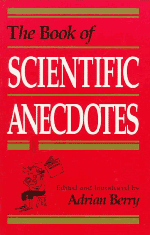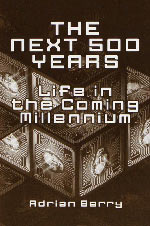

Adrian
Berry visited Starlab on Friday 19th May, 2000, to give a talk
on Space exploration and Stellar Flights. Mr. Berry is a best-selling
author, whose books include Galileo and the Dolphins, The Next 500 Years
and Eureka! The Book of Scientific Anecdotes. The hugely popular writer
Douglas Adams has named Adrian Berry as a major inspiration.
Mr. Berry was in the Press Room at Houston during the moon landing in
july 1969, and his wide experience as a Science Correspondent includes
19 years with The Daily Telegraph. Since 1996 he has been devoting most
of his time to writing books - one of his volums, The Next Ten Thousand
Years sold half a million copies - but he still writes regularly for The
Daily Telegraph in London, and for Astronomy Now. Adrian Berry is a Fellow
of the Royal Astronomical Society, the Royal Geographical Society and
the British Interplanetary Society, and a member of the Planetary Society
in the USA. There was a frisson during Mr Berry's talk when he talked
about the ideas of Dr. Serguei Krasnikov, since Dr. Krasnikov has now
joined Starlab. This talk provoked some discussion with Adrian Berry,
and opinions have continued to circulate in Starlab about it.
Will There be any Politicians in the Distant Future?
I want to look ahead
to a period about 500 years into the future to two alternative futures.
They are very different from each other. In the first, it will be
impossible for politicians to exist, and in the second it is inevitable
that they will still be controlling our lives.
The two futures I'm going to consider don't have to be 500 years ahead.
They could be 5,000 years ahead. But assuming that technology continues
to progress at its present rate, let's say 500 years.
What will people
be doing in 500 years? Many things, obviously. What interests me is that
by that time we'll be very much closer to the stars than we are today,
both intellectually and physically. In fact we'll be travelling to them.
I want to suggest today that there may be two ways of travelling to the
stars, and that they would each
create profoundly different social systems.
The first is to travel very fast, at close to the speed of light which,
as we shall see would create a society without politicians. The second
is to travel instantaneously, to disappear in one part of space and reappear,
a fraction of a second later, in another. This as we shall see, would
create a highly politicised society.
But first let's consider the option of very high speeds.
Travelling fast
enough to reach the stars within reasonable voyage times will of course
will be very difficult because they are very far away. To get to them
before one is
dead of old age, one has to go very very, very fast. Our fastest vessels
of today, the space shuttles, that fly at 17,000 mph, would take 170,000
years to reach Alpha
Centauri, the nearest star!
But judging by the
past, we have an impressive record in learning how to travel faster.
Until about 1850, the fastest anyone could travel was 30 mph, the speed
of a galloping horse. In slightly more than a century this maximum speed
has increased by nearly 600- fold, or 60,000 per cent! Now that's an interesting
statistic. Project that rate of increase forward another century into
the future, and by then we'll be travelling at
10 million mph (15 million kph), about one sixth of the speed of light.
Now even travelling
at 10 million mph it would still take nearly 300 years to reach Alpha
Centauri, and I don't think that would interest many travellers. So let's
be
conservative and say that within 500 years we'll have learned to travel
at 92 per cent of the speed of light, 615 million mph (980 kph), which
experts I've consulted think is a good compromise between very high speed
and the enormous difficulties of accelerating any further. (For the closer
you get to the speed of light, the more massive your spaceship gets. On
the other hand, you have to travel extremely fast to reach your destination.
So 90 or 92 per cent of the speed of light seems a reasonable compromise.
It's approximately a million times faster than a jumbo jet, if you want
to know.)
At this speed, people on Earth would measure the time it took the brave space travellers to reach Alpha Centauri at 4.6 years.
But for the space
travellers themselves it wouldn't take so long. Because time slows down
on board a very fast-moving vehicle, the
journey, to them, would take just under two years! (I'm not going to make
any suggestions here about how spaceships can be accelerated to that enormous
speed,
whether it requires an antimatter engine, or what. Anyone interested can
find some details in my book The Giant Leap, which is now out in paperback.)
Who is going to pay
for such journeys, and why? Governments are not going to pay for them,
why should they? They would hardly wish thousandsÄor millionsÄof their
citizens to go off to planets from which they would never return, and
never again pay them taxes. Don't expect to find a manned trip to Alpha
Centauri listed in NASA's
budget for the fiscal year 2501 or any other fiscal year!
Instead, I suggest that they will be paid for by private traders, since it will actually be quite easy to make money out of them.
Consider the slowing
down of time in a fast-moving ship Äthe faster you travel, the more it
slows down. (This fact is a centrepiece of Einstein's special theory of
relativity of 1905.) Now consider a rich trader who wanted to become even
richer could take advantage of this. Here on Earth. he will invest a large
part of his wealth at compound interest so that it grew exponentially.
He would then head an expedition to Alpha Centauri (or some other star
where a habitable planet had been discovered)
with several hundred would- be colonists. He would return to Earth alone,
on the same fast ship that took him there, and collect his accumulated
wealth.
He would have only
have aged three or four years, while his money would have been accumulating
for 20 or 30 years! He would now be vastly richer than he was before,
and in a position to finance further trips, and so on.
Einstein, it can be seen, not only discovered a new physical universe; he has also given us a new financial universe.
With many such traders
pursuing these schemes, many star systems could be opened up for human
colonisation, perhaps, eventually, a significant part of our Milky Way
galaxy. This would be a galaxy without politicians, for no government
stationed on one planet could ever enforce its will on any other planet,
the inhabited planets being so many light-years apart. There would only
be local politicians. For in this vision of the future it is impossible
to travel faster than light. You cannot even reach the speed of
light and remain part of this universe. If a government on Planet A heard
that there was a rebellion against its authority on Planet B many light-years
away, they would not
get the news until decades or centuries after it had happened, and it
would take that long again for them to do something about it, by which
time the rebels might long be dead.
But who says we
have to remain in this universe? What if it was possible to travel faster
than light? Not, I must say at once, through ordinary space, which is
ruled out
by the special theory of relativity, but by making instantaneous ``jumps''
through ``hyperspace'', as characters are always doing in science fiction.
This is my alternative
future, in which politicians would be everywhere, for it would be possible
to built a galactic empire, since no planet in the galaxy would be no
more than a few weeks' travel time from any other.
Is this a fantasy? Nobody knows. The answer is likely to be found in Einstein's 1916 general theory of relativity which is much more subtle and complex than the special theory. The space agency NASA has recently held two seminars to explore the question of whether this extraordinary 55-page document, packed with tensor equations, might support the principle of hyperspace travel.
Ostensibly, the theory
only states that matter creates the space and time which surround it,
indicating that space has an elastic, or warped character. But this is
not all!
The 1916 equations have been compared with a Trojan Horse. Outwardly,
there is little more in them than a description of light and space being
bent by gravity. But in fact,
as one physicist has remarked, within them lurk all sorts of strange ``goblins
and demons'', black holes, time travel and other universes. In particular
there are wormholes which are believed to lead directly to other regions
in space.
Now wormholes have been, until recently been believed to be incredibly tiny, no more than a billionth of a trillionth of a trillionth of an inch, 33 powers of 10 smaller than a human thumbnail, the smallest size it is possible for anything in the universe to be, rather difficult, in fact, for a spaceship to enter!
But recent calculations by Serguei Krasnikov, a relativity theorist at the Polkovo Observatory in St Petersburg, suggest that this may not always be true. He has shown that wormholes may be large, large enough for a spaceship to penetrate.
So one day passengers
in a star-liner may hear the following announcementÄthis is a quotation
from Isaac Asimov's novel The Stars Like Dust: ```This is the captain
speaking. We are ready for our first jump. We will be temporarily leaving
the space-time fabric to enter the little-known realm of Hyperspace, where
time and distance have
no meaning. It is like travelling across a narrow isthmus from one ocean
to another, rather than circling a continent to accomplish the same distance.
There will only be
minor discomfort. Please remain calm.' `
`It was like a bump which joggled the deep inside of a man's bones. In a fraction of a second the star view from the portholes had changed radically. The centre of the great Galaxy was closer now, and the stars appeared to thicken in number. The ship had moved a hundred light-years closer to them.''
In this society, of course, you would have the benefits of being able to travel anywhere you wanted, but also the disadvantages of have to suffer from cosmic Napoleons and interstellar wars, since, if starliner passengers can travel through hyperspace, so can fleets and armies.
I don't know which of these two futures one would prefer to live in. But it will not be a matter of what one prefers. The question will be decided m cosmic Napoleons and interstellar wars, since, if starliner passengers can travel through hyperspace, so can fleets and armies.
I don't know which
of these two futures one would prefer to live in. But it will not be a
matter of what one prefers. The question will be decided by truths about
the universe
that are still hidden from us.





